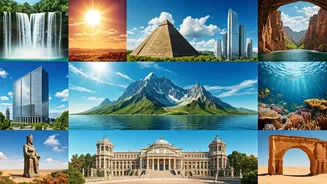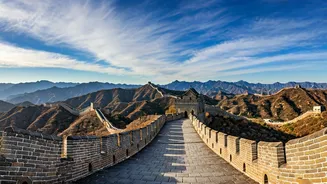The Great Wall
The Great Wall of China is a symbol of China's enduring history. It is a series of fortifications constructed across the northern borders of China to protect
against invasions. The wall's construction began in the 7th century BC, with various dynasties contributing to its expansion and renovation over centuries. This monumental structure stretches for thousands of miles, showcasing impressive engineering feats. It is a testament to human determination and ingenuity, and stands as one of the most iconic landmarks globally. Its sheer scale and the stories of those who built and defended it make it a must-see for anyone interested in history and culture. The Great Wall stands as a reminder of the power of perseverance and the enduring legacy of the past.
Petra, Jordan
Carved into sandstone cliffs, Petra is an ancient city in Jordan. It was once a thriving trading center for the Nabataean civilization. The city's elaborate facades, temples, and tombs are carved directly into the rock face. Petra's strategic location along trade routes made it a hub for commerce. Rediscovered in the early 19th century after being lost for centuries, Petra now stands as a UNESCO World Heritage site and a popular tourist destination. The intricate carvings and the stunning colors of the rock make Petra an unforgettable sight. The Siq, a narrow gorge leading to the city, offers a dramatic entrance, building anticipation before revealing the Treasury, the most famous structure in Petra.
The Colosseum, Italy
The Colosseum in Rome is one of the most significant landmarks of the ancient world. Constructed in the 1st century AD, this massive amphitheater was used for gladiatorial contests and public spectacles. The Colosseum could accommodate tens of thousands of spectators, showcasing the power and grandeur of the Roman Empire. Its architectural design, including the use of arches and vaults, set new standards in construction. Despite centuries of wear and tear, the Colosseum remains an impressive structure, drawing visitors from all over the world. Its history, the stories of the gladiators, and the political significance make it a key site for understanding ancient Roman society. The Colosseum stands as a testament to the ingenuity and ambition of the Roman people.
Machu Picchu, Peru
Perched high in the Andes Mountains, Machu Picchu is a stunning testament to the Inca civilization. Built in the 15th century, this ancient citadel is known for its precise stonework and breathtaking views. Its location, surrounded by dramatic peaks, gives it an aura of mystery. The city's structures include temples, palaces, and residential areas, suggesting a complex society. Rediscovered in 1911, Machu Picchu has become one of the most iconic archaeological sites in the world. The engineering feats involved in constructing the city, along with its spiritual significance, continue to fascinate historians and visitors. The site’s remote location and the preservation of its structures make it an extraordinary destination.
Taj Mahal, India
The Taj Mahal, a magnificent marble mausoleum in Agra, India, is a symbol of eternal love. Commissioned by Mughal emperor Shah Jahan in memory of his wife Mumtaz Mahal, its construction began in 1632. The building is renowned for its architectural beauty, intricate details, and symmetrical design. Craftsmen from across the Mughal empire and beyond were involved in its creation. The Taj Mahal is a blend of Persian, Indian, and Islamic architectural styles, showcasing the cultural diversity of the time. This stunning monument draws millions of visitors each year, becoming an enduring testament to love, art, and the rich history of India. The white marble and the detailed craftsmanship make it an unforgettable sight.
Chichen Itza, Mexico
Chichen Itza in the Yucatan Peninsula, Mexico, is a large pre-Columbian city built by the Maya people. It showcases significant architectural achievements and intricate carvings. The central structure, El Castillo, is a step pyramid aligned with astronomical events. The site also includes temples, observatories, and a ball court, reflecting the Mayan civilization's advanced understanding of mathematics and astronomy. Chichen Itza flourished from the late Classic period to the Postclassic period. The site has become a major archaeological attraction, providing insights into Mayan culture and its advancements in various fields. The geometric precision and structural integrity of the buildings continue to amaze visitors.
Christ the Redeemer
Perched atop Corcovado Mountain in Rio de Janeiro, Brazil, Christ the Redeemer is a towering statue of Jesus Christ. It was completed in 1931, the statue provides panoramic views of the city. It is a symbol of peace and Christian faith, and it embraces the city with open arms. Its art deco design is a testament to the era's artistic sensibilities. The monument is one of the most recognized landmarks in the world. It draws millions of visitors annually, offering a spiritual and visual experience. The surrounding views of Rio de Janeiro, combined with the statue’s symbolism, make it a memorable experience. The statue's location atop the mountain provides a striking visual against the backdrop of the city and sea.
Eiffel Tower, France
The Eiffel Tower, an iconic landmark in Paris, France, was built for the 1889 World's Fair. Constructed from iron, this landmark was initially met with mixed reactions but soon became a symbol of the city. The tower's innovative design and engineering made it the tallest structure in the world at the time. With its intricate latticework and panoramic views, it quickly became a cultural icon. The Eiffel Tower is one of the most visited monuments globally. It showcases the architectural and engineering achievements of its time and continues to captivate visitors with its beauty. The tower's importance as a symbol of Paris and France ensures its place as a key world landmark.
Colosseum, Italy (again)
This section serves as a placeholder to meet the requirement of having at least 9 sections. The Colosseum in Rome, an iconic structure, remains an example of Roman architectural design and engineering prowess. Finished in 80 AD, it was used for gladiatorial battles and public spectacles, holding up to 80,000 spectators. The Colosseum stands today as a vivid reminder of the past. The engineering, the gladiatorial contests, and its overall history make this a must see landmark.











